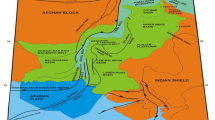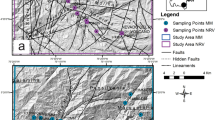Abstract
Carbonate reservoirs in the Middle East hold a significant proportion of the remaining conventional oil reserves, which most of them were classified as naturally fractured. These reservoirs are well known for their low recoveries compared with their counterpart clastic unfractured reservoirs. Therefore, boosting their recoveries can assure to sustain the energy supply to the global oil markets. In this work, an example from the Middle East has been used to evaluate the impact of the fracture characteristics on the reservoir performance using four decades of production history. The characteristics of natural fractures have a remarkable impact on fluid flow behaviour in fractured reservoirs. Besides, these characteristics, such as fracture intensity, determines the matrix block dimensions, which in turn, influence the matrix recovery. However, it is challenging to estimate the fracture characteristics accurately due to the scarcity of the fracture data from subsurface measurements. Therefore, outcrop analogue data can be utilised to enhance the fracture modelling in fractured reservoirs and to fill the data gap between the seismic scale and well scale. In this work, we have integrated the outcrop fracture data with the core observations to improve the fracture modelling in the studied reservoir. Furthermore, a sensitivity study was carried out to investigate the impact of flow curves, gravity drainage mechanism, and its parameters, as well as the fracture storativity on the history matching in fractured reservoirs. Excellent matching results were obtained for the majority of the wells, as indicated by the low mismatch values. The obtained results highlighted the importance of fractures on the fluid flow behaviour, and hence the reservoir performance. Therefore, fracture properties should not be abusively modified using multipliers and local adjustment to avoid nullifying the reservoir characterisation efforts and degrade the simulation model capability for a future prediction.


The location of the Jambur field has indicated by a blue star, courtesy of Al-Qayim et al. (2010)



















Similar content being viewed by others
Abbreviations
- a :
-
Aperture (m)
- k :
-
Permeability (mD)
- k r :
-
Relative permeability (fraction)
- φ :
-
Porosity (fraction)
- σ :
-
Shape factor (1/m2)
- Lz, Lx, Ly :
-
Matrix block dimension (m)
- SD:
-
Standard deviation
- P sat :
-
Saturation pressure (psi)
- B :
-
Formation factor (RB/STB)
- R s :
-
Solution gas (scf/bbl)
- µ :
-
Viscosity (cp)
- τ :
-
Transfer function (bbl/D)
- P :
-
Pressure (psi)
- P c :
-
Capillary pressure (psi)
- ρ :
-
Density (lb/ft3)
- S :
-
Saturation (fraction)
- x, y, and z :
-
Grid directions
- f:
-
Fracture
- m:
-
Matrix
- o:
-
Oil phase
- g:
-
Gas phase
- i:
-
Initial
- r:
-
Residual
- l:
-
Liquid
- c:
-
Critical
References
Agada S, Geiger S, Wettability Doster F (2016) Hysteresis and fracture-matrix interaction during Co2 EOR and storage in fractured carbonate reservoirs. Int J Greenh Gas Control 46:57–75. https://doi.org/10.1016/j.ijggc.2015.12.035
Agarwal B, Hermansen H, Sylte JE, Thomas LK (2000) Reservoir characterization of Ekofisk field : a giant, fractured chalk reservoir in the Norwegian North Sea-History Match. SPE Reserv Eval Eng 3(6):534–543. https://doi.org/10.2118/68096-PA
Ahmed T (2006) Reservoir engineering handbook, 3rd edn. Gulf Professional Publishing, Elsevier Inc., United States of America
Aljuboori F, Corbett P, Bisdom K, Bertotti G, Geiger S (2015) Using outcrop data for geological well test modelling in fractured reservoirs. In: 77th EAGE Conference and Exhibition 2015: Earth Science for Energy and Environment; 2015. https://doi.org/10.3997/2214-4609.201413037
Aljuboori FA, Lee JH, Elraies KA, Stephen KD (2019) Gravity drainage mechanism in naturally fractured carbonate reservoirs; review and application. Energies. https://doi.org/10.3390/en12193699
Aljuboori FA, Lee JH, Elraies KA, Stephen KD (2020) The effectiveness of low salinity waterflooding in naturally fractured reservoirs. J Pet Sci Eng 191:107167. https://doi.org/10.1016/j.petrol.2020.107167
Al-Qayim B, Qadir F, Al-Biaty F (2010) Dolomitization and porosity evaluation of the Cretaceous Upper Qamchuqa (Mauddud) formation, Khabbaz Oil Field, Kirkuk Area, Northern Iraq. GeoArabia 15(4):49–76
Barenblatt GI, Zheltov IP, Kochina IN (1960) Basic concepts in the theory of seepage of homogenous liquids in fissured rocks [Strata]. PMM 24(5):852–864
Bergbauer S (2007) Testing the predictive capability of curvature analyses. Geol Soc Lond Spec Publ 292(1):185–202. https://doi.org/10.1144/SP292.11
Bertels SP, DiCarlo DA, Blunt MJ (2001) Measurement of aperture distribution, capillary pressure, relative permeability, and in situ saturation in a rock fracture using computed tomography scanning. Water Resour Res 37(3):649–662
Bisdom K, Nick HM, Bertotti G (2017) An integrated workflow for stress and flow modelling using outcrop-derived discrete fracture networks. Comput Geosci 103:21–35. https://doi.org/10.1016/j.cageo.2017.02.019
Bust VK, Oletu JU, Worthington PF, Gaffney, Associates C (2009) The challenges for carbonate petrophysics in petroleum resource estimation. In: IPTC-13772-MS. IPTC: International Petroleum Technology Conference held in Doha, Qatar 2009
Bust VK, Oletu JU, Worthington PF (2011) The challenges for carbonate petrophysics in petroleum resource estimation. SPE Reserv Eval Eng 14(01):25–34. https://doi.org/10.2118/142819-PA
Chandra VS, Geiger S, Corbett P, Steele R, Milroy P, Barnett A, Wright PV (2013) Using Near wellbore upscaling to improve reservoir characterisation and simulation in highly heterogeneous carbonate reservoirs. In: SPE-166033-MS. Society of Petroleum Engineers: SPE Reservoir Characterisation and Simulation Conference and Exhibition held in Abu Dhabi, UAE 2013. https://doi.org/10.2118/166033-MS
Elfeel MA, Geiger S (2012) Static and dynamic assessment of DFN permeability upscaling. In: SPE Eur. Annu. Conf., 2012, No. June, 4–7. https://doi.org/10.2118/154369-MS
Elfeel MA, Jamal S, Enemanna C, Arnold D, Geiger S (2013) Effect of DFN upscaling on history matching and prediction of naturally fractured reservoirs. In: 75th Eur. Assoc. Geosci. Eng. Conf. Exhib. 2013 Inc. SPE Eur. 2013 Chang. Front., https://doi.org/10.2118/164838-MS
Garcia M, Gouth F, Gosselin O (2007) Fast and efficient modeling and conditioning of naturally fractured reservoir models using static and dynamic data. In: Proc. Eur. Conf. Exhib., 2007, No. SPE 107525, 20. https://doi.org/10.2118/107525-MS
Geiger S, Matthäi S (2012) What can we learn from high-resolution numerical simulations of single and multi-phase fluid flow in fractured outcrop analogues. Geol Soc Lyell Collect. https://doi.org/10.1144/SP374.8(Special Pu)
Geiger S, Cortis A, Birkholzer JT (2010) Upscaling solute transport in naturally fractured porous media with the continuous time random walk method. Water Resour Res 46:12. https://doi.org/10.1029/2010WR009133
Ghaedi M, Masihi M, Heinemann ZE, Ghazanfari MH (2015) History matching of naturally fractured reservoirs based on the recovery curve method. J Pet Sci Eng. https://doi.org/10.1016/j.petrol.2014.12.002
Gilman JR, Kazemi H (1983) Improvements in simulation of naturally fractured reservoirs. SPE-10511-PA. https://doi.org/10.2118/10511-PA
Gilman JR, Ozgen C (2013) Reservoir simulation: history matching and forecasting. Society of Petroleum Engineers, Richardson
Guo G, Evans RD (1994) Geologic and stochastic characterization of naturally fractured reservoirs. In: SPE-27025-MS. Society of Petroleum Engineers: Latin American/Caribbean Petroleum Engineering Conference held in Buenos Aires, Argentina. 1994. https://doi.org/10.2118/27025-MS
Jassim SZ, Buday T, Goff JC (2006) Geology of Iraq, First.; Dolin, Prague and Moravian Museum, Brno,: Czech Republic
Jenni S, Hu LY, Basquet R, de Marsily G, Bourbiaux B (2004) History matching of stochastic models of field-scale fractures: methodology and case Study. In: SPE-90020-MS. Society of Petroleum Engineers: SPE Annual Technical Conference and Exhibition held in Houston, Texas, USA 2004. https://doi.org/10.2118/90020-MS
Jensen JL, Lake LW, Corbett PWM, Goggin DJ (2000) Statistics for petroleum engineers and geoscientists, 2nd edn. Elsevier, The Netherlands
Jiang L, Pan W, Cai C, Jia L, Pan L, Wang T, Li H, Chen S, Chen Y (2015) Fluid mixing induced by hydrothermal activity in the ordovician carbonates in Tarim Basin. China. Geofluids 15(3):483–498. https://doi.org/10.1111/gfl.12125
Kazemi H, Gilman JR (1993) Multiphase flow in fractured petroleum reservoirs. In: Bear J, Tsang C-F, de Marsily G (eds) Flow and contaminant transport in fractured rock. Elsevier, Imprint Academic Press. https://doi.org/10.1016/C2009-0-29127-6
Kazemi H, Merrill LS Jr, Porterfield KL, Zeman PR (1976) Numerical simulation of water-oil flow in naturally fractured reservoirs. SPE-5719-PA. https://doi.org/10.2118/5719-PA
Lewis H, Hall SA, Guest J, Couples GD (2007) Kinematically-equivalent but geomechanically-different simulations of fault evolution: the role of loading configurations. Geol Soc Lond Spec Publ 292(1):159–172. https://doi.org/10.1144/SP292.9
Li Y, Chen S, Lu J, Wang G, Zou X, Xiao Z, Su K, He Q, Luo X (2020) The logging recognition of solid bitumen and its effect on physical properties, AC, resistivity and NMR parameters. Mar Pet Geol 112:104070. https://doi.org/10.1016/j.marpetgeo.2019.104070
Lucia FJ (2007) Carbonate reservoir characterization, an integrated approach, 2nd edn. Springer Berlin Heidelberg, New York. https://doi.org/10.1007/978-3-540-72742-2
Maier C, Geiger S (2013) Combining unstructured grids, discrete fracture representation and dual-porosity models for improved simulation of naturally fractured reservoirs. In: SPE-166049-MS. Society of Petroleum Engineers: SPE Reservoir Characterisation and Simulation Conference and Exhibition held in Abu Dhabi, UAE 2013. https://doi.org/10.2118/166049-MS
Moore LV (1984) Significance, classification of asphaltic material in petroleum exploration. Oil Gas J 82(41):109–112
Morris AP, Ferrill DA, McGinnis RN (2007) Conceptual fracture model for Zagros oilfields using the Qara Chauq anticline as an analog. In: Dep. Earth, Mater. Planet. Sci. Geosci. Eng. Div. Southwest Res. Institute, Confid. Rep. North Oil Company, Iraqi Minist. Oil
Nejadi S, Trivedi JJ, Leung J (2017) History matching and uncertainty quantification of discrete fracture network models in fractured reservoirs. J Pet Sci Eng 152:21–32. https://doi.org/10.1016/j.petrol.2017.01.048
NOC (1980) Well reports; Kirkuk
Oliver DS, Chen Y (2011) Recent progress on reservoir history matching: a review. Comput Geosci 15(1):185–221
Pieters DA, Graves RM (1994) fracture relative permeability: linear or non-linear function of saturation. In: International Petroleum Conference and Exhibition of Mexico. Society of Petroleum Engineers: Veracruz, Mexico, 10–13 October 1994, p 10. https://doi.org/10.2118/28701-MS
Sablok R, Aziz K (2008) Upscaling and discretization errors in reservoir simulation. Pet Sci Technol 26(10–11):1161–1186
Sadooni FN, Alsharhan AS (2003) Stratigraphy, microfacies, and petroleum potential of the Mauddud Formation (Albian–Cenomanian) in the Arabian Gulf Basin. Am Assoc Pet Geol AAPG Bull 87(10):1653–1680. https://doi.org/10.1306/04220301111
Saleri NG, Toronyi RM (1988) Engineering control in reservoir simulation: part I. Soc Pet Eng SPE 18305. SPE Annual Technical Conference and Exhibition, 2–5 October, Houston, Texas, pp 421–435. https://doi.org/10.2118/18305-MS
Suzuki S, Daly C, Caers J, Mueller D (2007) History matching of naturally fractured reservoirs using elastic stress simulation and probability perturbation method. SPE J. https://doi.org/10.2118/95498-PA
Van Harmelen A, Weijermars R (2018) Complex analytical solutions for flow in hydraulically fractured hydrocarbon reservoirs with and without natural fractures. Appl Math Model 56:137–157. https://doi.org/10.1016/j.apm.2017.11.027
Warren JE, Root PJ (1963) The behavior of naturally fractured reservoirs. SPE-426-PA. https://doi.org/10.2118/426-PA
Welbon AIF, Brockbank PJ, Brunsden D, Olsen TS (2007) Characterizing and producing from reservoirs in landslides: challenges and opportunities. Geol Soc Lond Spec Publ 292(1):49–74. https://doi.org/10.1144/SP292.3
Wennberg OP, Svånå T, Azizzadeh M, Aqrawi AMM, Brockbank P, Lyslo KB, Ogilvie S (2006) Fracture intensity vs. mechanical stratigraphy in platform top carbonates: the Aquitanian of the Asmari Formation, Khaviz Anticline, Zagros. SW Iran Pet Geosci 12(3):235–246
Wennberg OP, Azizzadeh M, Aqrawi AAM, Blanc E, Brockbank P, Lyslo KB, Pickard N, Salem LD, Svana T (2007) The Khaviz Anticline: an outcrop analogue to giant fractured Asmari formation reservoirs in SW Iran. In: Fractured reservoirs; The Geological Society, London, 2007; Vol. Special Pu, pp 23–42
Williams MA, Keating JF, Barghouty MF (1998) The stratigraphic method: a structured approach to history-matching complex simulation models. SPE Reserv Eval Eng 1(2):169–176. https://doi.org/10.2118/38014-PA
Acknowledgements
The authors would like to express their deepest gratitude to Universiti Teknologi PETRONAS for providing the required software license and creating the necessary working environment. The authors would also like to thank the Ministry of Oil of Iraq and the management of North Oil Company for their permission to use their data in this work.
Author information
Authors and Affiliations
Corresponding authors
Additional information
Publisher's Note
Springer Nature remains neutral with regard to jurisdictional claims in published maps and institutional affiliations.
Rights and permissions
About this article
Cite this article
Aljuboori, F.A., Lee, J.H., Elraies, K.A. et al. Effect of fracture characteristics on history matching in the Qamchuqa reservoir: a case study from Iraq. Carbonates Evaporites 35, 87 (2020). https://doi.org/10.1007/s13146-020-00607-3
Accepted:
Published:
DOI: https://doi.org/10.1007/s13146-020-00607-3




